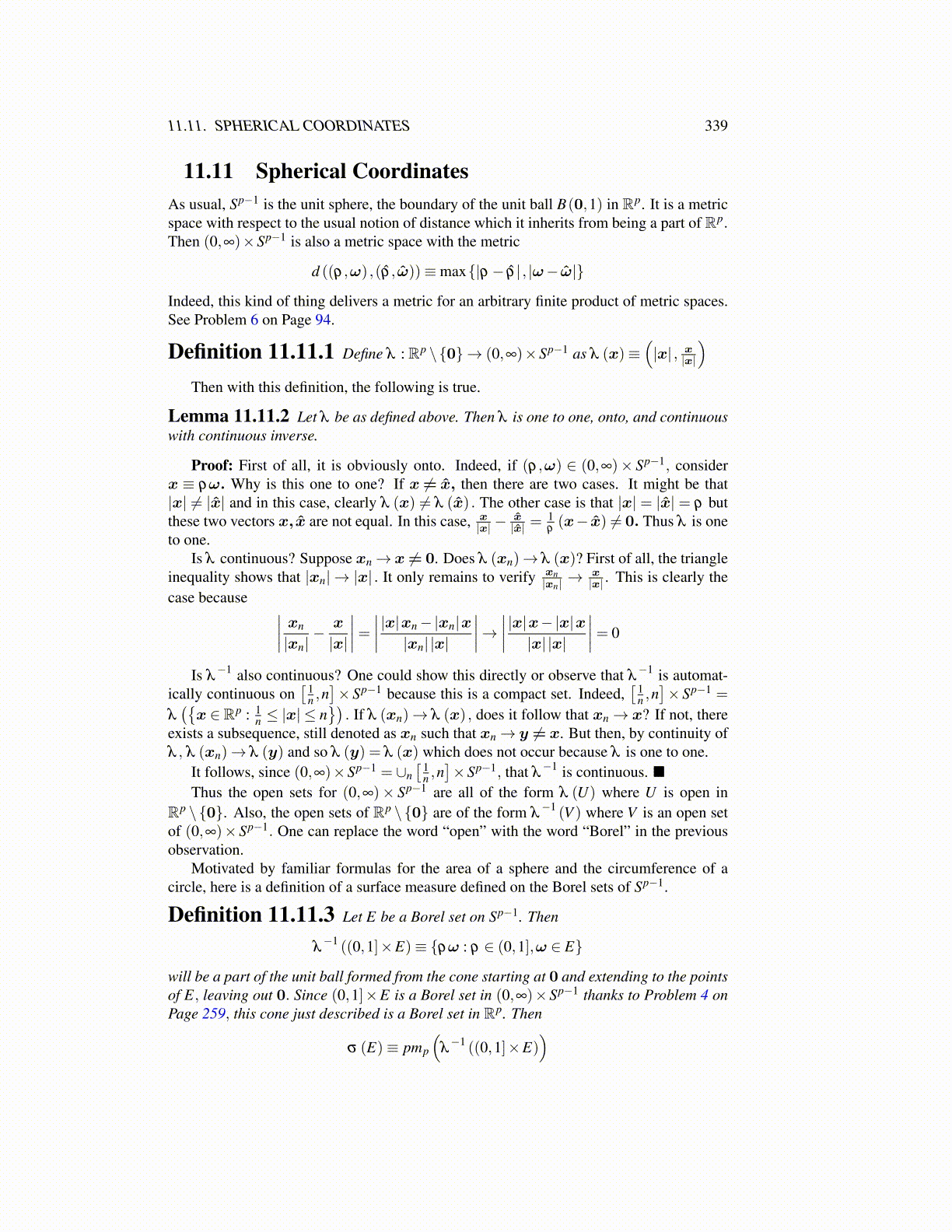
11.11. SPHERICAL COORDINATES 339
11.11 Spherical CoordinatesAs usual, Sp−1 is the unit sphere, the boundary of the unit ball B(0,1) in Rp. It is a metricspace with respect to the usual notion of distance which it inherits from being a part of Rp.Then (0,∞)×Sp−1 is also a metric space with the metric
d ((ρ,ω) ,(ρ̂, ω̂))≡max{|ρ− ρ̂| , |ω− ω̂|}
Indeed, this kind of thing delivers a metric for an arbitrary finite product of metric spaces.See Problem 6 on Page 94.
Definition 11.11.1 Define λ : Rp \{0}→ (0,∞)×Sp−1 as λ (x)≡(|x| , x
|x|
)Then with this definition, the following is true.
Lemma 11.11.2 Let λ be as defined above. Then λ is one to one, onto, and continuouswith continuous inverse.
Proof: First of all, it is obviously onto. Indeed, if (ρ,ω) ∈ (0,∞)× Sp−1, considerx ≡ ρω. Why is this one to one? If x ̸= x̂, then there are two cases. It might be that|x| ̸= |x̂| and in this case, clearly λ (x) ̸= λ (x̂) . The other case is that |x| = |x̂| = ρ butthese two vectors x,x̂ are not equal. In this case, x
|x| −x̂|x̂| =
1ρ(x− x̂) ̸= 0. Thus λ is one
to one.Is λ continuous? Suppose xn→ x ̸= 0. Does λ (xn)→ λ (x)? First of all, the triangle
inequality shows that |xn| → |x| . It only remains to verify xn|xn| →
x|x| . This is clearly the
case because ∣∣∣∣ xn
|xn|− x
|x|
∣∣∣∣= ∣∣∣∣ |x|xn−|xn|x|xn| |x|
∣∣∣∣→ ∣∣∣∣ |x|x−|x|x|x| |x|
∣∣∣∣= 0
Is λ−1 also continuous? One could show this directly or observe that λ
−1 is automat-ically continuous on
[ 1n ,n]× Sp−1 because this is a compact set. Indeed,
[ 1n ,n]× Sp−1 =
λ({x ∈ Rp : 1
n ≤ |x| ≤ n})
. If λ (xn)→ λ (x) , does it follow that xn→ x? If not, thereexists a subsequence, still denoted as xn such that xn→ y ̸= x. But then, by continuity ofλ , λ (xn)→ λ (y) and so λ (y) = λ (x) which does not occur because λ is one to one.
It follows, since (0,∞)×Sp−1 = ∪n[ 1
n ,n]×Sp−1, that λ
−1 is continuous. ■Thus the open sets for (0,∞)× Sp−1 are all of the form λ (U) where U is open in
Rp \{0}. Also, the open sets of Rp \{0} are of the form λ−1 (V ) where V is an open set
of (0,∞)× Sp−1. One can replace the word “open” with the word “Borel” in the previousobservation.
Motivated by familiar formulas for the area of a sphere and the circumference of acircle, here is a definition of a surface measure defined on the Borel sets of Sp−1.
Definition 11.11.3 Let E be a Borel set on Sp−1. Then
λ−1 ((0,1]×E)≡ {ρω : ρ ∈ (0,1],ω ∈ E}
will be a part of the unit ball formed from the cone starting at 0 and extending to the pointsof E, leaving out 0. Since (0,1]×E is a Borel set in (0,∞)×Sp−1 thanks to Problem 4 onPage 259, this cone just described is a Borel set in Rp. Then
σ (E)≡ pmp
(λ−1 ((0,1]×E)
)